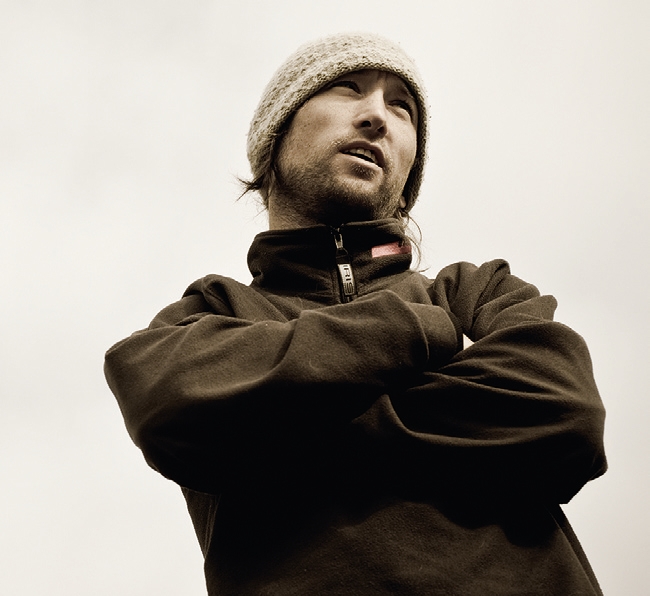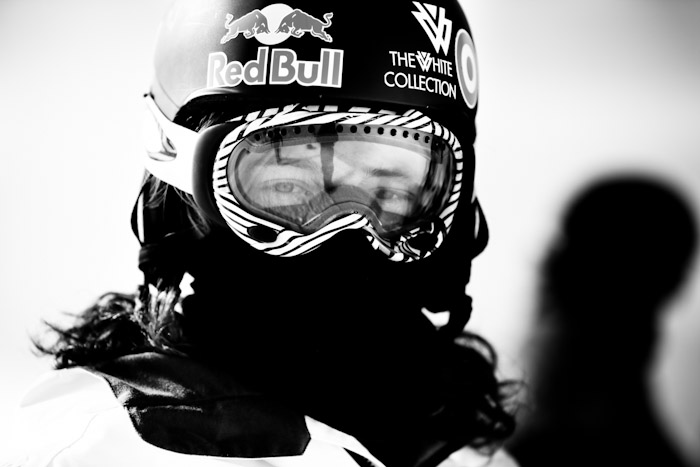Taken from Whitelines Issue 103 October 2012
Words by Andrew Duthie
Photos: Oli Gagnon
Earlier this year Travis Rice set out to redefine snowboard competition. Bankrolled by Red Bull, he created a unique backcountry slopestyle course and invited the world’s best to ride it. So did he succeed?
Moving into the future, I believe that more progressive contest formats are the ticket to keeping snowboarding fresh.
So said a 24-year-old Travis Rice in his first Whitelines interview back in 2007 (WL #75). He wasn’t the first snowboarder to sound off about the state of competitive snowboarding in these pages, and he wouldn’t be the last. In this instance he’d been quizzed about his involvement with David Benedek’s revolutionary big air contest, The Gap Session. Less of a snowboard comp than a manifesto, Bene’s show had proved to the world that the best people to run snowboard events were the riders themselves. At the time, Travis didn’t get specific about where he saw contests going, but it’s clear now that some ideas were quietly germinating. Five years later, they were being realised on a scale that would have seemed preposterous back then, and in many ways still does. It would be a big risk that, if done right, had the potential to change the sport forever. Never mind the World Snowboard Championships; would 2012 be the year of Supernatural?
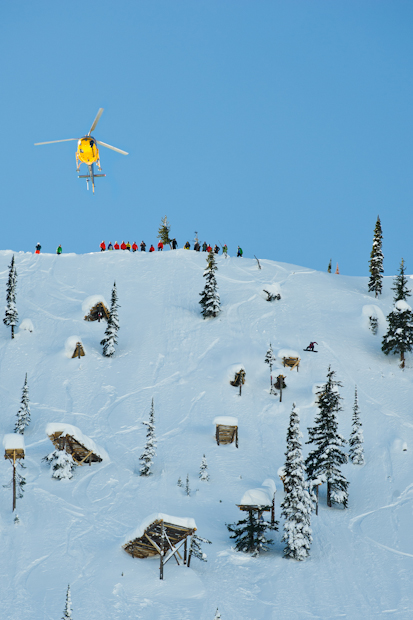
During the build up, Travis had spelled out where the idea for the project had come from: “Five years ago…. snowboarding was broken up into two sectors, essentially. You had the contest side and you had this adventure film side. There was some crossover but there wasn’t anything that highlighted the best of both worlds.” In the years since, he established himself as the crossover snowboarder; winning X-Games and Air & Style gold one minute, spearheading big-budget film projects That’s It, That’s All and The Art Of Flight the next. Who better, then, to try and bridge the gap? He first gave it a go in 2008 with the Natural Selection event at his home mountain of Jackson Hole, Wyoming. With top riders, all-natural features and a contest format, Natural Selection laid the framework for what was to come. Supernatural, as the name suggested, would up the ante. Once Canada’s Baldface Mountain had been selected as the venue, plans were put in motion and Red Bull started writing cheques (the event would slot nicely into their ‘Signature Series’ of extreme sports events). Invites were soon winging their way to Natural Selection’s highest scorers, as well as a few freeride legends that no self-respecting contest could overlook. To round out the field of 18, and to add to the ‘crossover’ theme, a couple of wildcard entries were reserved for the TTR World Tour’s best freestylers. Of course, most of this was happening behind the scenes, and it wasn’t until the first trailer for the event dropped that we saw just how Travis had spent his summer.

At first it was the sheer scale of the thing that grabbed the headlines. By Red Bull’s estimation the nine professional loggers had clocked over 2500 man-hours in the construction of more than 80 individual wooden features. Once the sawdust settled, the end result looked like a Go Ape centre on crack; in truth, it was hard to picture just how it would all translate into a rideable course come winter-time. Let’s not forget that the canvas was a mile-long pow field with a vertical drop of over 2200 feet. The top of Baldface’s ‘Scary Cherry’ is as steep as 55 degrees in places, levelling to a steady 35 degrees further down. Throw in some expertly crafted park-style booters and slopestyle features (albeit with pow landings) and you’re left with the most formidable backcountry contest run ever envisioned. Judging a course like this would be no mean feat, so freeriding legends including Bryan Iguchi, Tom Burt, Temple Cummins and Shin Campos were charged with overseeing the points system. All that was needed was snow, and by mid-February the course was caked. It was time to see if Travis’ great experiment would pay off.
“Even the organisers would have to admit that it’s a work in progress… only a couple of riders kept any real flow between the wooden constructs and the kicker section”
Appropriately it was Scotty Lago that dropped first. The 24-year-old star of both The Art of Flight and X-Games slopestyle is just the kind of rider that Supernatural was designed for. Thanks to a botched 540 up top, his guinea-pig run was solid if not especially impressive. Powder guru David Carrier-Porcheron was up next, eclipsing Scotty’s score despite being the wrong side of 30 and picking up a knee injury that ruled him out of a second run. Immediately it looked like the older, more experienced participants would be the ones to beat. As legend after legend took their drop, the unforgiving course threw riders from comfort-zone cruising to window-winding panic in the space of a few turns. Tricky powder landings saw a return to old-school methods and slow, steezy spins, while modern-day acrobatics were put to one side. Nowhere was this better illustrated than by the sight of TTR slopestyle champ Mark McMorris making his first descent. A world away from triple-corking success at the X-Games, the 19-year-old wildcard entrant had spent his howler of a run mostly on his backside, and suffered the indignity of the day’s first ragdoll. Meanwhile, Terje Haakonsen sailed through the course with his usual serene steeze, on legs twice as old as McMorris’.
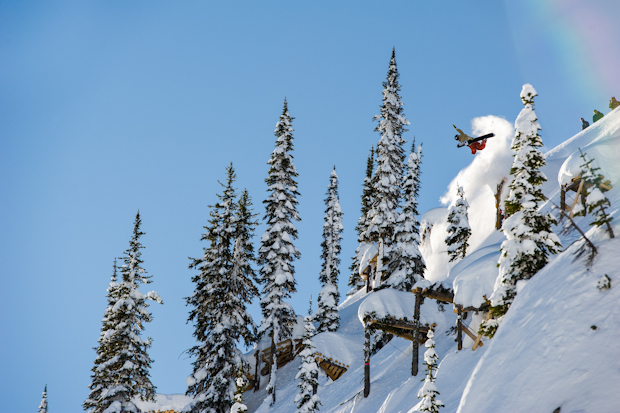
The grizzled pow fiends may have had the upper hand, but it was still anyone’s to win, especially when the second runs began. Having had the chance to scope each others’ efforts, riders began upping their game appropriately. Eric Jackson’s moment of buttery brilliance off the helipad was one of the day’s best tricks, showing real creativity on a feature that most were happy to just launch off. Explained E-Jack at the bottom of his run, “Nobody else was doing butter tricks, so I tried to be a little different.” Likewise, 24-year-old Lucas Debari dropped jaws with an enormous straight air, operating on the logic that “the only way to win would be to do something insane to beat Travis.” Unlike the halfpipe or slopestyle, where routines are rehearsed to perfection and usually just repeated for run number two, here it was about improvising and responding to what the rest of the field had delivered. Here even the double cork was an original element, thrown only by John Jackson in the kicker section. Absolutely everyone brought their A-game in a last-ditch attempt to score big, and even the unfortunate McMorris managed a vast improvement on his second go. Suddenly he and fellow wildcarder Sage Kotsenburg didn’t look so out of place after all. To their eternal credit, both chose to rock up to this as no-hopers rather than grab an assured podium place at the Innsbruck Air & Style, which was taking place at the same time.
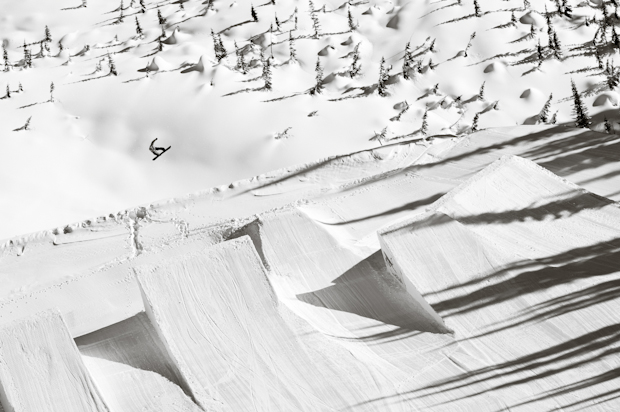
In the end no amount of Debari balls, Haakonsen style or Jackson acrobatics could stop Trice, whose runs were comfortably the two highest scoring of the day. Some balked at the notion of first place going to the guy who planned the event but, given that he had exactly the same amount of practice as the others (zero), only a fantasist could claim it was a fix. On the day he came closest to delivering what the event set out to capture, getting more out of the course than anyone else. Far from delivering a pair of polished, techy runs, Trav was happy to throw the odd backflip or shifty 360 into the mix just for fun (we’re reminded of another nugget from his ’07 interview: “I tend to do best at competition when I don’t take it so serious”). Long-time cohorts Gigi Rüf and Nicolas Müller deservedly took second and third in what turned out to be a relatively easy call for the judges. After years of planning and months of preparation, it was all over.

“Kier ambushed breathless riders at the bottom of the course like a beanie-clad John Inverdale”
It wasn’t without its flaws, of course, and even the organisers would have to admit that it’s a work in progress. After the manic first section both Jake Blauvelt and Kazuhiro Kokubo seemed to get a bit lost, and soon they were struggling to find anything worth hitting. In fact, only a couple of riders kept any real flow between the wooden constructs and the kicker section. In Supernatural’s current state, it hasn’t yet met Trav’s vision of a two-minute run that could stand up to a two-minute video part. The rider list was questionable in places, especially when it came to Natural Selection alumni. In a fast-moving sport, it’s hard to see why so much stock had been put in the results of a contest held four years previously. Was it just a ploy to get some of the organiser’s mates on the invite list? Then there’s the biggie: Trice and his deep-pocketed friends had turned their focus to the one aspect of snowboarding that, for the most part, has so far avoided the glare of the mainstream spotlight. The crossover aim was all well and good but, for many, these two aspects of snowboarding are separate for a reason. The emergence of trailers hyping Supernatural as both “a Travis Rice creation” and “a television event like no other” wouldn’t help matters – was this to be just another sideshow for American telly?
Indeed, for all its talk of ‘game-changing’, the coverage of Supernatural was as predictable as it gets. US television network NBC snapped up the rights and promptly roped in the X-Games’ usual suspects, including action sports TV’s utility man Sal Masekela (sample insight: “You can literally feel how steep it is just standing here”) and Indycar/college gridiron commentator Todd Harris. The team was rounded out by former pro snowboarders Todd Richards and Kier Dillon, two halfpipe riders not exactly known for their backcountry prowess. While flashy graphics threw up rider bios and leaderboards, a microphone-wielding Kier ambushed breathless riders at the bottom of the course like a beanie-clad John Inverdale.
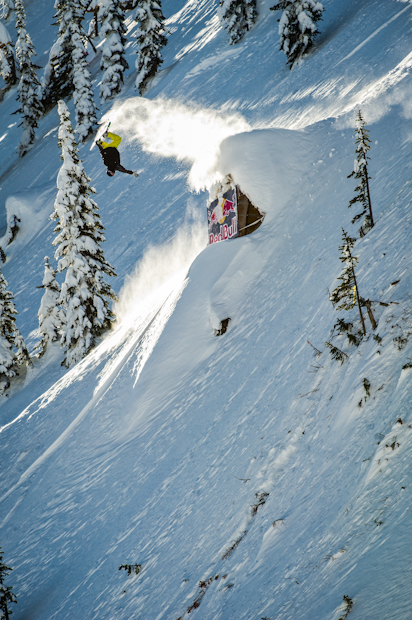
Not that it was all bad; the vignettes of avalanche control and the contest’s organisation were entertaining enough, even if the latter was billed as a journey “inside the mind of Travis Rice” (another Sal gem). And while they may have fetishised the kicker section with their trademark overkill slo-mo, in general Brain Farm Cinema did a great job of shooting the proceedings. Best of all was the footage of competitors kicking back in the lodge, playing ping pong, or riding pow together just for the fun of it. This comp may have seen backcountry snowboarding take one step towards mainstream competition, but the other foot had stayed put.
To be fair to NBC, they could be forgiven for not pushing the boat out. Binning a tried-and-tested format for something more original may have done greater justice to Supernatural, but that sense of familiarity no doubt served to hold the attention of the target audience (without whom the contest would never have been ‘given wings’, so to speak). If Supernatural also encouraged some of those viewers to strap in for the first time, so much the better.
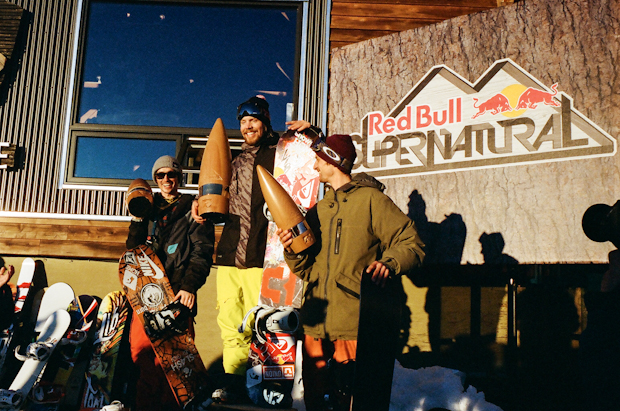
It’s best to view the TV treatment as a necessary part of the bigger plan. With Supernatural, Travis’ goal was to make connections (between contests and backcountry adventure; between the old guard and the new blood; between the fringe element and the mainstream) and it’s hard to deny that he’d succeeded. There were hiccups, even before the first rider had dropped, and the format is unlikely to catch on in the way that slopestyle (soon to make its Olympic debut) has. Still, telling Travis Rice not to go any further than Natural Selection would have been like telling Alexander the Great to knock it on the head after invading Persia. He looks back as much as he looks forward, and we should be all thankful that the man with the resources and the initiative to take contest riding to new places also has the sport’s core values at heart. Roll on Supernatural 2013.

